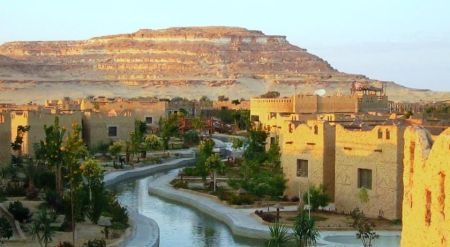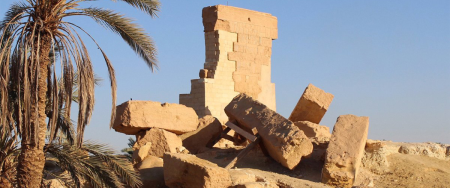Oracle of Amun

The Oracle of Amun: Ancient Egypt’s Sacred Voice of Divine Wisdom
Hidden within the remote sands of the Siwa Oasis, the Oracle of Amun stands as one of Egypt’s most mystical and spiritually charged sanctuaries. This ancient temple, dedicated to the powerful god Amun, was more than a religious site—it was the beating heart of prophecy, politics, and divine counsel during Egypt’s golden eras. For centuries, rulers and commoners alike journeyed across the vast desert, seeking the wisdom of this oracle whose words shaped destinies and kingdoms. Among its most famous visitors was Alexander the Great, who sought confirmation of his divine heritage within these hallowed walls. The Oracle of Amun remains a living testament to how faith, power, and mystery intertwined in ancient Egyptian civilization.
Today, the ruins of this sacred site continue to draw historians, travelers, and spiritual seekers. Its aura of divine mystery lingers in every stone, whispering tales of priests interpreting the will of the gods. The Oracle of Amun isn’t merely a relic—it’s a symbol of Egypt’s enduring connection between heaven and earth, reminding modern visitors that ancient belief systems were profoundly sophisticated and deeply tied to cosmic understanding. For those exploring Egypt Travel Packages, a journey to Siwa and the Oracle of Amun unveils one of the most captivating chapters of Egyptian spirituality.
Historical Origins of the Oracle of Amun
The Oracle of Amun dates back to Egypt’s 26th Dynasty, during a period when Amun’s cult spread beyond Thebes and found deep roots across the nation. The temple at Siwa, known locally as the Temple of the Oracle, was a spiritual outpost far from the Nile Valley yet intimately connected with the empire’s religious network. Amun, often depicted as a ram-headed deity, symbolized creation, fertility, and divine kingship. The priests of Amun were not just religious figures—they were intermediaries between gods and men, wielding immense influence.
Legend suggests that the oracle gained prominence when Pharaohs began consulting it on state matters, wars, and successions. Pilgrims crossed treacherous terrain to reach Siwa, believing that Amun’s voice echoed through selected priests. These divine messages were often cryptic but carried immense authority. Over time, the Oracle of Amun became a cornerstone of Egypt’s spiritual infrastructure, joining the ranks of other monumental temples such as Karnak Temple and Luxor Temple.
The Role of the Oracle in Ancient Egyptian Politics
In ancient Egypt, divine approval wasn’t optional—it was essential. Pharaohs claimed legitimacy through the blessing of gods, and the Oracle of Amun often served as the mouthpiece of divine sanction. When Alexander the Great visited Siwa in 331 BCE, his motives were not merely curiosity. He sought the oracle’s validation that he was the son of Zeus-Amun, a confirmation that elevated his status from conqueror to god-king. This encounter solidified the oracle’s fame across the Mediterranean world. The pronouncement at Siwa shaped Alexander’s campaign and reinforced the fusion between Greek and Egyptian spiritual traditions.
The priests of the oracle, shrouded in ritual secrecy, interpreted omens through sacred symbols, natural signs, and trance-like states. Their authority influenced decisions on wars, alliances, and royal decrees. The temple’s strategic isolation fostered an aura of mystique, enhancing its role as a divine mediator in Egypt’s political landscape.
Architectural Splendor of the Temple of Amun
Built from local limestone atop a rocky plateau, the Temple of the Oracle of Amun in Siwa combined elegance with function. Though weathered by time, the temple’s ruins reveal traces of intricate carvings and hieroglyphs dedicated to Amun. The temple’s layout included a sanctuary, prayer halls, and chambers for rituals and prophecy. Visitors entered through a grand courtyard before approaching the inner sanctum, where the sacred oracle resided.
The structure’s design bore similarities to other Theban temples yet adapted to the oasis environment. Set against the backdrop of the desert’s golden dunes and palm groves, it symbolized divine presence amidst isolation. Its commanding view over the oasis reinforced the connection between celestial power and earthly life. Many travelers today combine visits to this temple with nearby landmarks like Shali Castle and the Temple of Umm Ubayd, immersing themselves in the oasis’s blend of history and spirituality.
Religious Significance and the Cult of Amun
Amun’s influence extended far beyond Siwa. As Egypt’s “hidden one,” he embodied the unseen essence of creation. The Oracle of Amun, therefore, wasn’t merely a temple—it was a gateway to divine insight. Through complex rituals, priests invoked Amun’s spirit to deliver guidance. The process might have involved smoke, chanting, and sacred objects, creating an ethereal environment where the divine voice could be heard. This sacred communication was believed to maintain cosmic balance, reaffirming the pharaoh’s role as the earthly representative of divine order.
The devotion to Amun also reflected Egypt’s philosophical understanding of the universe. Amun’s hidden nature symbolized the mystery of existence itself—a belief that the divine could be felt but never fully seen. The oracle’s prophecies, therefore, carried profound philosophical and theological undertones, shaping Egyptian thought for millennia.
The Oracle of Amun and Alexander the Great’s Divine Journey
Few events in history have captured the imagination quite like Alexander’s pilgrimage to the Oracle of Amun. After conquering Egypt, he marched through the arid expanse of the Western Desert to seek Amun’s counsel. Ancient accounts describe how the oracle welcomed him as “son of Zeus-Amun,” affirming his divine lineage. This moment transformed Alexander’s image from a mortal ruler into a semi-divine figure, blending Greek heroism with Egyptian theology. His visit also strengthened ties between the Greco-Macedonian world and Egypt, marking the dawn of the Hellenistic era.
Even centuries later, historians and travelers continued to recount tales of Alexander’s journey to Siwa, fueling the site’s legendary reputation. Today, visitors retracing his path can experience the same awe as they explore the desert’s silence and the ruins that once echoed with the voice of the gods. Many combine this spiritual pilgrimage with Egypt Nile Cruises or desert expeditions like the Egypt Desert Tours, blending adventure with ancient mysticism.
Rediscovery and Modern Exploration of the Oracle of Amun
Centuries of desert winds buried much of the temple in sand until modern archaeologists began uncovering its remains. Early European explorers were mesmerized by Siwa’s isolation and its ancient tales of prophecy. Excavations revealed architectural fragments, inscriptions, and relics that confirmed the temple’s sacred functions. Archaeologists continue to study the site, unveiling new insights into its role in Egypt’s religious network.
For travelers today, visiting the Oracle of Amun is both a historical and spiritual experience. The journey through Siwa’s palm groves and salt lakes evokes the same mystic energy that once drew pilgrims. The site’s preservation has become a point of pride for Egypt’s cultural heritage initiatives, ensuring that future generations can witness the grandeur of Egypt’s spiritual landscape.
Traveling to the Oracle of Amun Today
Modern explorers can reach Siwa Oasis via desert routes from Marsa Matruh or Cairo, often included in curated Egypt Luxury Tours and eco-adventures. The oasis offers more than the oracle itself—it’s home to the Mountain of the Dead, Cleopatra’s Spring, and the tranquil beauty of the Great Sand Sea. The combination of mysticism, natural wonder, and ancient ruins creates an unforgettable journey through Egypt’s spiritual history.
Visitors can explore the temple ruins, admire the panoramic views, and connect with the timeless energy that once inspired pharaohs and conquerors. Whether you’re an archaeology enthusiast, spiritual traveler, or simply curious adventurer, the Oracle of Amun delivers an experience unlike any other. The site stands as a reminder that Egypt’s desert still holds secrets waiting to be rediscovered.
Frequently Asked Questions About the Oracle of Amun
Where is the Oracle of Amun located?
The Oracle of Amun is located in the Siwa Oasis, a remote desert settlement in Egypt’s Western Desert, near the Libyan border. The temple sits on a rocky hill overlooking the oasis, surrounded by palm groves and salt lakes. Its isolation adds to its mystique, making it a unique destination for travelers seeking spiritual and historical depth.
Who built the Oracle of Amun?
The temple was built during Egypt’s Late Period, likely under the 26th Dynasty. It was dedicated to the god Amun, whose worship had spread from Thebes. The sanctuary was constructed by local craftsmen using limestone, blending Theban design with Siwan architectural influence. The temple’s purpose was to serve as a place of prophecy and divine communication.
Why did Alexander the Great visit the Oracle of Amun?
Alexander the Great visited the Oracle of Amun in 331 BCE to confirm his divine lineage. The oracle’s priests addressed him as the son of Zeus-Amun, solidifying his claim to divinity. This encounter had profound political implications, strengthening his rule over Egypt and inspiring his vision of a unified empire that blended cultures and beliefs.
What makes the Oracle of Amun significant today?
Today, the Oracle of Amun symbolizes the enduring power of faith and prophecy in ancient Egyptian culture. It’s a vital archaeological site that reveals insights into Egypt’s spiritual practices, architecture, and political history. For visitors, it offers a direct link to the mystical world of pharaohs, gods, and ancient wisdom.
How can travelers visit the Oracle of Amun?
Travelers can reach the Oracle of Amun by joining organized desert tours from Cairo or Marsa Matruh. Many include visits to surrounding attractions like Dakrour Mountain and nearby hot springs. Combining this experience with broader Egypt Vacation Packages ensures a rich and comprehensive journey through Egypt’s ancient wonders.
The Oracle of Amun continues to fascinate scholars and travelers alike. Its ruins whisper of a time when gods spoke through men, shaping destinies with divine counsel. In the heart of the desert, the spirit of Amun still lingers—an eternal echo of Egypt’s sacred past and a beacon for those who seek to understand the deep mysteries of human faith and cosmic order.







